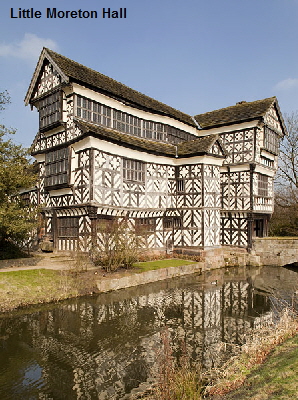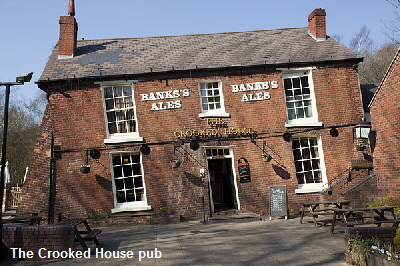|
Off the straight and narrow
Britain’s crooked buildings, stooping under the weight of history, have an irresistible charm. Craig Roberts goes off the straight and narrow
It has to be said that buildings are at their best when built straight, vertical and symmetrical and most structures do conform to this standard. This not only adds strength to the build, but makes them fit neatly next to their nearest neighbour and the many others that surround it. It is with a sense of charm then, that the occasional oddity is looked upon as not only unique, but much loved and very much the local hero in the town.
Whilst we may not have anything in the UK to quite rival Pisa’s star attraction, we do have quite a few that have enough lean to them to make them stand out from the crowd and yet you may not have discovered yourself yet.
Although we have some newer, ‘designed’ examples, most are of an age and have arrived at the incline by accident, usually subsidence and therefore are on close watch and their future is doomed unless they can be stabilised.
Perhaps our oldest example is Caerphilly Castle, the second largest castle in Britain and built in the Norman design. Designed by Earl Gilbert de Clare, its inner and outer walls and clever water defence system were groundbreaking at the time and a high point of medieval architecture and part of what makes it one of Wales’ most popular attractions. However, it’s the castle’s south-east leaning tower, that actually out leans Pisa’s tower, that people remember the castle for the most. The tower has split vertically and is part destroyed. Is it a victim of subsidence, as is the case in many examples or did the Parliamentarians during the Civil War botch their attempt to destroy the tower to gain access to the castle in 1648? This might explain why the rest of the castle remains intact, but theories remain inconclusive on this one.
 |
Dunwich in Suffolk was once a whole town of wonky structures, with several church towers dominating. Now that these have long been taken by the North Sea, neighbouring Lavenham has become the defining town, much loved for its numerous wonky buildings. This medieval wool town, has some of the country’s finest timber framed buildings and are either leaning precariously into the street or as the ones in Church Street are, seemingly leaning into one another, as if nodding off to sleep.
Little Moreton Hall in Cheshire is arguably our finest timber framed, moated manor house. It’s south front appears very drunk and its aesthetic appeal lies both in the variety of chequerboard patterns of black timber and white mortar and the way that the house appears to be collapsing slowly under its own weight. The lack of furnishing and decoration throughout, gives visitors an almost unique opportunity to study Tudor building techniques and architecture. The lopsided appearance is largely due to the fact that the entire South wing has little or no foundation. Iron-tie rods were inserted at the end of the 19th Century as a further precaution against collapse and it is suggested that the heavily decorated fireplace in the Upper Porch Room, just off the Long Gallery, is the only true vertical in the house!
Over in Tewksbury in Gloucestershire, you’ll find the House of the Golden Key, which was once a depot and ticket office for the stagecoaches that served the attractive town. Today however, it is a home to a High Street building society, but despite this, it has lost none of its charm. It’s a classic 16th Century black and white timber framed building, heightened by one story in the 17th Century. It is also known as the House of the Nodding Gables as a result of a break in the ridge piece of the new structure, which caused it to slip forward, giving it it’s slanted appearance.Other timber-framed examples can be found in Canterbury, where a black and white house leans into the Palace Street at a very odd angle and the quaint and crooked Market Cross House in Windsor. This was originally a butcher’s shop when it was rebuilt in 1718 and has since been a florist, pub and antiques shop. Now a popular teashop, its crooked appearance is due to structural alterations in the 18th century.
The tallest and therefore perhaps most precarious example is St Mary and All Saints church in Chesterfield, Derbyshire. At 228ft tall, it leans over seven feet to the south and four feet to the west. The crooked spire was added to the tower in the 14th Century and has become subject of many local legends as to how the misshape came about. Locally they will tell you it’s because the devil sat on it whilst passing from Sheffield to Nottingham or that a beautiful maiden walked by and sent the spire wild with lustful desire. Others will tell you that it was designed that way. There is also a tale that the spire was so shocked to learn of the marriage of a virgin in the church that it bent over to get a closer look. It is said that the spire will straighten and return to its true position should this happen again. Sadly, the reality has to do more with lead plates being laid by unskilled craftsmen herringbone fashion over unseasoned timber beams. Instead of collapsing under the weight, they just twisted and bent. It has been strengthened and hopefully the twist of 45 degrees and lean will remain for years to come.
 |
If visiting these buildings leaves you feeling a little drunk and queasy, then perhaps you should avoid (or relish!) the Crooked House pub in Himley, West Midlands. First built in 1765 as a farmhouse, it later became a public house called the Siden House (Siden being Black Country dialect for crooked).
Its leaning effect is due to local mining in the 1800’s, when the building was badly affected by subsidence, meaning that one side of the building is now four feet lower than the other! It then became the Glynne Arms, named after Sir Stephen Glynne, on whose land it stood before being condemned as unsafe in 1940s.
 Thankfully this wonderful building was rescued by Wolverhampton and Dudley Breweries, when it was reinforced with supporting buttresses and girders. Now known as The Crooked House, it has become a tourist attraction and is visited by thirsty travellers from all over the world. The level floors combined with the leaning walls can create some very intriguing optical illusions, where glasses can slowly slide across tables and you should ask to see the marble roll uphill. Thankfully this wonderful building was rescued by Wolverhampton and Dudley Breweries, when it was reinforced with supporting buttresses and girders. Now known as The Crooked House, it has become a tourist attraction and is visited by thirsty travellers from all over the world. The level floors combined with the leaning walls can create some very intriguing optical illusions, where glasses can slowly slide across tables and you should ask to see the marble roll uphill.
Most people get a boost from popping to the pub, but customers to the Crooked House get a sinking feeling when they walk through the door and you can leave feeling very drunk, even if you have only been on the orange juice all evening!
Despite, the lessons learnt from past building techniques, it would appear that we now want wonky buildings and some modern versions have been purposely built this way. The Gherkin in London, although not necessarily wonky, doesn’t conform to the skyscrapers that surround it and its unusual shape is eye catching to say the least. Across the River Thames however, is another modern build that does have a positive lean to it. City Hall or ‘The Egg’ as it is sometimes called, is a most unique building, which pays homage to our most crooked buildings of past and stands proud as the modern day equivalent. Hopefully this structure has no fear of subsidence with its design and is home to the Mayor of London. Designed by leading architect Lord Norman Foster, it doesn’t really have a front or back and its shape is derived from a geometrically modified sphere.
 |
Lets hope this isn't the last structure to be built which breaks convention, as these buildings have become part of our heritage and are a refreshing break from the norm. The older versions may have come about by accident, but we welcome their lean and they add a unique character to their location. They have an irresistible charm and I for one love them for it.
All images and text copyright © Craig Roberts 2011
|